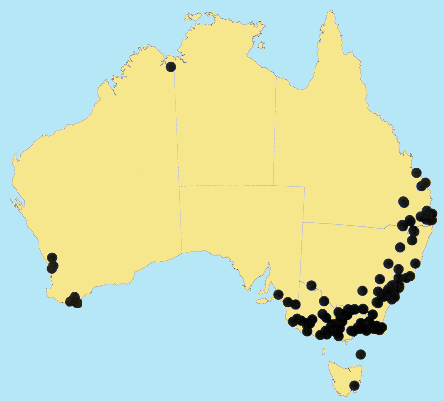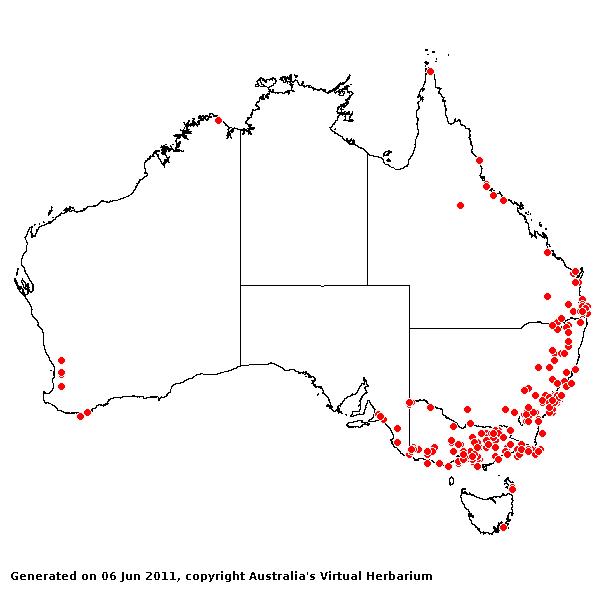Setaria parviflora (Poiret) M. Kerguelen.
Lejeunia 120: 161 (1987).
Classification. (GPWG 2001) : Subfamily
Panicoideae. Paniceae.
Basionym and/or
Replacement Name: Cenchrus
parviflorus Poir., Encycl. 6: 52 (1804).
Type of Basionym or Protologue Information: Puerto Rico:, M. Ventenat s.n.
(HT: P).
Recent synonyms: S. geniculata var. geniculata, S.
geniculata var. pauciseta,
S. gracilis var. gracilis, S. gracilis var. pauciseta.
Key references
(books and floras): [1952] C.A.Gardner, Flora of Western Australia 1
Gramineae (265 as S. geniculata), [2002] D.Sharp & B.K.Simon,
AusGrass, Grasses of Australia, [2006] J.Jessop, G.R.M.Dashorst,
F.M.James, Grasses of South Australia (482), [2008] S.W.L.Jacobs,
R.D.B.Walley & D.J.B.Wheeler, Grasses of New South Wales (369).
Illustrations:
[1984] N.T.Burbidge. rev. S.W.L.Jacobs, Australian Grasses (241 as S. geniculata), [2006]
J.Jessop, G.R.M.Dashorst, F.M.James, Grasses of South Australia (483, fig. 416), [2008] S.W.L.Jacobs,
R.D.B.Whalley & D.J.B.Wheeler, Grasses of New South Wales, 4th edn
(369).
Habit.
Perennial. Rhizomes absent or present, short. Culms erect or geniculately
ascending, 30–110 cm tall. Mid-culm internodes hollow, thin-walled. Mid-culm
nodes glabrous. Leaf-sheaths glabrous on surface. Ligule a fringe of hairs,
0.4–1.2 mm long. Leaf-blades 10–30 cm long, 2–7 mm wide. Leaf-blade surface
scabrous.
Inflorescence.
Inflorescence solid, a panicle. Panicle linear, 2–6 cm long, 0.8–1.4 cm wide.
Spikelets.
Spikelets pedicelled, 1 in the cluster. Involucre composed of bristles. Fertile
spikelets 2-flowered, the lower floret barren (rarely male), the upper fertile,
comprising 1 basal sterile florets, comprising 1 fertile floret(s), without
rachilla extension, lanceolate or elliptic, dorsally compressed, 2.2–2.8 mm
long.
Glumes. Glumes
thinner than fertile lemma. Lower glume ovate, membranous, without keels, 3–5
-nerved. Upper glume ovate, 1.3–1.8 mm long, membranous, without keels, 5
-nerved. Florets. Basal sterile florets 1, barren, with palea. Lemma of
lower sterile floret 100 % of length of spikelet, membranous, 5 -nerved.
Fertile lemma 2–2.6 mm
long, without keel. Anthers 3. Grain 1.7 mm long.
Continental
Distribution: Africa, Temperate Asia, Tropical Asia, Australasia, Pacific,
North America, and South America.
Australian
Distribution: Western Australia, South Australia, Queensland,
New South Wales, Victoria, Tasmania.
Western
Australia: Gardner.
Drummond, Menzies. South Australia: Murray, Southern Lofty,
South-eastern. Queensland: Darling
Downs, Moreton, Wide
Bay. New South Wales:
North Coast, Central Coast, South Coast, Northern Tablelands, Central
Tablelands, Southern Tablelands, North-Western Slopes, Central-Western Slopes,
South-Western Slopes, North-Western Plains. Victoria:
East Gippsland, Eastern Highlands, Gippsland Plain, Murray Mallee, Riverina. Tasmania: Furneaux Group, East Coast.
Notes. Very
similar to S. pumila, the only diagnostic difference is that S.
parviflora is a perennial with a short rhizome whereas S. pumila is
an annual. Incomplete specimens are frequently impossible to identify. Setaria
parviflora is also easy to confuse with S. sphacelata.
In tropical and
subtropical rain forests, tropical and subtropical wet sclerophyll forests,
temperate wet sclerophyll forests, dry sclerophyll forests, Brigalow forests,
tropical and subtropical sub-humid woodlands, semi-arid shrub woodlands, acacia
shrublands, arid tussock grasslands, coastal grasslands, and tropical sub-humid
grasslands. Flowers Jan.-Apr.
Formerly separated
into varieties var. gracilis and var. pauciseta under a previous
name S. gracilis, but these are now thought not worth maintaining.






